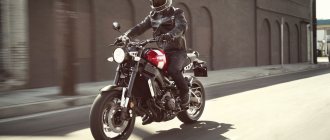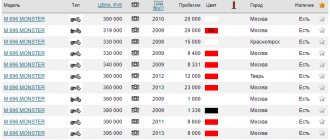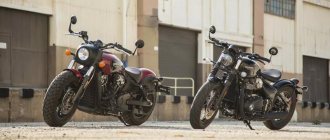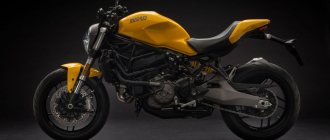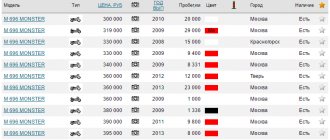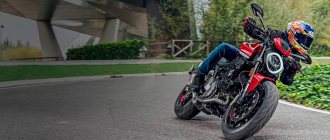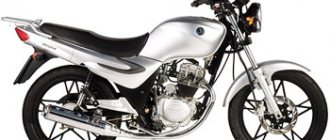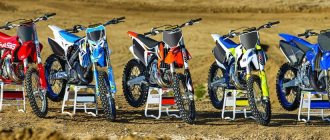Comparison participants
On my first ride on the Indian FTR1200, the exhaust pipes suggested comparisons to the Ducati Monster, and the Monster 1200S had just been updated, so that goes without saying. I admit that the Yamaha XSR is a little out of the woods here with its 847cc triple versus the 1200cc twin. But when I saw the XSR in the dealer's garage, I literally said, "wow, is that really an old flat tracker you have here?"
With the XSR, Yamaha was clearly aiming for the same image as Indian. So why not add this model to the comparison? The Yamaha XSR has been on the market for several years, but we haven’t really tested it, much less compared it with others. So it’s decided - let’s take it.
Well, since we already have an unusual comparison of city motorcycles, we decided to take another non-standard step. We took two Indians—a base model and an S—largely because Indian agreed to give them to us. The S model comes with a 4.5” LCD display, tilting ABS, traction control, three ride modes and adjustable suspension.
Indian FTR1200
Indian FTR1200
Both Indian FTRs come with cruise control, but the Yamaha and Monster do not. The regular FTR has regular ABS, is painted glossy black and has a round instrument panel instead of an LCD screen.
Everyone criticizes Indian’s small tank (12.8 liters), and engineers brush it off, saying that the FTR is a motorcycle for the city and nearby suburbs. Total bullshit, of course, but the truth is, Indian FTRs are truly chic around town. The seating position is high, the seat is soft, the steering wheel is wide. 15 centimeters of suspension travel, and what kind of suspension, and at both ends, allows you not to worry too much about the quality of the road surface, and 95 Nm at 3000 rpm allows you to leave the traffic light before the rest of the traffic begins to release the clutch pedal.
Well, since he clearly feels good in the city, let’s see how he behaves on the mountain road. Surely the lighter Ducati and Yamaha with 17 wheels will feel more confident on the serpentine road.
Armchair critics moaned and groaned that the Indian FTR handles poorly (which is to be expected from a motorcycle with 13 cm of trail and 18 and 19 inch wheels, a long wheelbase and heavy weight). And yes, they are slow and hard to steer, but they have big, wide bars and once you put some effort into them, the Indian FTRs are quite manageable. I had to try hard on the Ducati to keep up with the FTRs going down the hill. The advantage of large wheels is a large gyroscopic effect, which adds confidence on poor surfaces (or without it at all), and by the way, this is why there is a limit on the weight of wheels on a flat track. And Dunlop DT3 tires have excellent grip right up to the sidewalls.
Indian FTR1200S
Lean-sensing ABS and traction control should be even more confidence-inspiring (as long as you don't accidentally confuse the S with a regular FTR), but neither actually spooked us at any point. Subconsciously, we expected that American motorcycles would have low ground clearance and often shuffle their footpegs in turns, but in practice no one laid them down to the footpeg sliders.
However, on a particularly steep and narrow serpentine road, the Yamaha XSR900 performed best. At 198kg it's 34kg lighter than the Indian and 18kg lighter than the Monster, and its superb handling and smooth, linear pull let us know it's no stranger to this sort of thing.
Of course, the big twos are just amazing at getting to the top. The Monster is the only one with a quickshifter, thanks to which it shifts into second clearly and smoothly, and there is little motorcycle pleasure comparable to the roar and thrust of a big V-twin, extracted by opening the throttle. Play with the buttons and you can turn off the traction and wheelie control if you really want to. The Desmodromic Ducas will slingshot you into the next corner, and its top-of-the-line Brembos will pin you down so effectively you'll wonder why you're going so slow?
Indian FTRs feel like Monsters on steroids: the same powerful thrust in the second, even a little more powerful. The rear of the Dunlop FTRs wiggles a little more than the Diablo Rosso III the Ducati wears, but the wide handlebars give the illusion that everything is under complete control. The S version's Sport mode can feel a bit twitchy. The base model's only mode operates on the same map as the standard S mode. And it works as it should.
Indian FTR1200
Indians don't have a quickshifter, but their gearbox works quite well , although not as amazingly as Yamah's, and their slipper clutch is also excellent (though you need to get used to the narrow gray area). The FTR's front brakes are 320-size discs, the Monster's have 330-size discs, and the four-piston Brembo calipers found on the FTR are the junior model of the Ducati M50. Add to this the greater mass of the FTRs, and it becomes clear that they have weaker brakes than the Ducati and Yamaha. But weaker does not mean that they are bad, on the contrary, they stop the motorcycle clearly, informatively and linearly.
On serpentine roads, the Indian FTR doesn't lag much behind lighter companions made by companies with decades of racing heritage, but the faster you go on them, the more you wish the handlebars were narrower and lower.
I have to admit that both the Ducati Monster 1200S and Yamaha XSR900 are better suited to mountain roads and tight corners, but I'm glad the Indian FTR is as close as it gets.
Sure, it feels different due to the greater unsprung weight in the form of larger wheels and tires, but over time you get used to it and the FTRs feel like just another member of the same class of bike, rather than something decidedly different. For the company's first attempt at making a sports bike, this is a great result (let's not forget that Indian is not the same company as it used to be). Let's not point fingers, but some American manufacturers manage to fail a similar task over and over again.
Indian FTR1200 review No. 1
Indian has already had two serious successes, the first with the Chief and the second with the Scout, and FTR is a serious bid for the third. Indian has ruled the dirt oval in the past, and the slow trickle of information and photos about the road version of their flat tracker has me fidgeting in anticipation. My expectations seem to have been too rosy, because my enthusiasm after a day in the saddle of the Indian FTR1200 and FTR1200S deflates like a leaky balloon. Don't think that the Indian FTR is a bad bike, it's not. It's just bigger and heavier than I expected from a flat tracker. On narrow sections of serpentine, its wide handlebar made it possible to perfectly shift it from side to side, but sometimes you have to literally push it to do what you need.
The engine borrowed from the Scout has excellent low-end power, but adds significant weight to the bike, and its power-to-weight ratio is worse than the XSR's 847cc triple. The Indian FTR beats the Yamaha XSR in terms of thrust-to-weight ratio, but is easily beaten by the Ducati Monster 1200S. As far as driving up to 130 km/h is concerned, the kilometer-eating FTR is wonderful, but once you reach this speed, its engine clearly begins to tire and asks for a higher sixth. If you haven't already figured out from its looks that its powertrain is taken from a cruiser, you'll definitely feel it on the move. Visually, this is a chic city motorcycle that is difficult to classify as a specific class. Much like the Yamaha V-Max, the Indian FTR is a bike that transcends boundaries and categories and doesn't care about living up to anyone's expectations, and that should be respected.
Indian FTR1200 review No. 2
I was probably overexcited about the FTRs due to the long wait. Perhaps I associated them with the FTR750, the coolest device in its class, which took a ton of prizes on the flat track. And whatever the big Indian FTRs are, I was initially disappointed in them. Then I drove one of them and liked how it pulled at the top of the tachometer scale. Stunning, smile-inducing power. Just look at the dyno graphs. However, not everything is going smoothly with their traction: there is a noticeable dip in both torque and horsepower at 4-5 thousand, but rev it up more - and wow! In the end, it's like two different motorcycles for two different riding styles. In the first case, it’s the thrill of driving in low gear in high gear. Great for narrow, slow areas or in traffic jams. And when you want to clear your head, you crank it up to 5500 and off you go! In the upper range, the Indian FTR1200 is quite competitive with the Ducati Monster 1200S - right up to the FTR cutoff, after which Dukas simply goes further thanks to the 20 additional horses.
I wasn't particularly surprised that the FTRs steered slowly. Just look at the 19th front and 18th rear wheel! But the wide steering wheel helps to shift this weight in any series of turns. The tighter they are, the more effort this requires. While riding, I realized that the suspension of the standard Indian FTR is well tuned both front and rear, and if the rider is not too different from me (and I am 90 kg and 177 cm), then the S suspension is not particularly relevant. But the S has other advantages: I liked its colors, and the LCD instrument panel, although a bit large, is convenient to use thanks to touch controls.
I also like the ABS and traction control with lean tracking, especially given the powerful traction on less-than-ideal roads. But the absence of at least some kind of quickshifter is a big minus for a motorcycle in this segment. Both FTRs are fun bikes, but I didn't fall in love with them as much as expected. I guess I should drive the S a little longer and see what changes...
Indian FTR1200 review No. 3
I believe that a bike outside of classes and categories like the Indian FTR is not well suited to win a test like ours, where the class of the bike is important. In terms of style and wow factor, the FTRs passed this test with ease. Indian has done a great job of making a unique motorcycle, the FTR looks great and rides well. It turns like a truck, it’s true, and the gyroscopic effect not only makes it difficult to turn, but also prevents the engine from spinning up quickly, but the very fact that I can cheerfully drive up a mountain on a motorcycle with an Indian badge is already worth something. When it comes to fun, the Indian FTR is top notch; it's not often I've ridden a bike that's comfortable doing both wheelies and slide burnouts.
And I definitely wouldn't complain if I happened to drive it in the city. Its traction would be beneficial here, as would the wow factor: it is clearly visible on the road. When driving slowly, the exhaust makes it a little hot, but Ducati is generally an air fryer in this sense. A slight irony is cruise control. The fact that he exists is good. But the tank here is so small that you don’t have time to get tired of holding the gas. Aw, come on, guys from Indian, you guys are great, and FTR is awesome!
Sports, Tourist, Urban
The Ducati Monster 1200 R, as before, has three engine modes (Sport, Touring, Urban), which allow you to modify the throttle response and powerband based on your preferences or road conditions. Standard equipment includes traction control, which is adjustable in eight positions, and ABS, which is adjustable in three positions. We especially liked the most limited level of ABS performance (Level 1). On the track we tested the Ducati Monster 1200 R on, the system was barely noticeable, so we'd be very surprised if anyone ever wanted to turn it off completely. But on the other hand, it’s great that the manufacturer gives us such an opportunity.
Dashboard screen and fonts are clearer
It's surprising that the six-speed gearbox is not equipped with a quickshifter; at this price it should be available. Other than this shortcoming, we didn't have to think too much about the transmission, as gears shifted without a hitch.
All vital signs of the Ducati Monster 1200 R are displayed on a redesigned TFT display, which now includes a gear indicator. The screen itself and fonts are clearer, and once you get used to the menu functions and gear changes, it becomes very easy to manage settings while parked. However, it is still difficult to read information from the display if the sun's rays fall on it at right angles.
Ducati designers have improved performance
The Ducati Monster 1200 S version has always had good handling, but it feels low and long. Ducati designers have improved performance by raising the seat by 15 millimeters, physically increasing the length of the Ohlins suspension position, as well as the roll angle, which now reaches 50 degrees. Accordingly, the chassis geometry has changed slightly, as a result of which the angle of inclination and trail, as well as the wheelbase, have been reduced. One of the advantages of the configuration is the Ohlins steering damper. Marchesini cast aluminum wheels are shod with Pirelli Diablo Supercorsa SP performance tires. Another nice touch is the grippier, nicer aluminum running boards. The Ducati Monster 1200 R weighs 206.8 kg, which is 4 kg less than the S version.
Monster R - track bikes
Traditionally, Monster models have not been marketed as track bikes, but the R version changes that. The motorcycle, although maneuverable, has a less demanding driving position. The top-of-the-line Monster is a dream come true for riders looking for a sporty, yet more relaxed bike compared to pure racing superbikes. On the track it will give you maximum pleasure thanks to its speed. The eye is pleased to see the streamlined tail section, red stitching on the seat and shiny radiator cover.
The R 1200 is undoubtedly more monstrous than the S, but is it worth the money? If incredible sporty power and a natural, casual driving position are what you want, then you should really consider purchasing the Monster S.
Is it worth the money?
Advantages of the DUCATI MONSTER 1200 R:
- Excellent performance in the mid to high speed range
- Improved and more precise fuel delivery
- Panigale for gentlemen
Disadvantages of the DUCATI MONSTER 1200 R:
- Color display can be difficult to read
- Much more expensive than the S version
- Quickshifter missing
Ducati Monster 1200S
The Ducati Monster 1200S is updated for 2022, getting Ducati quickshifter and tilt ABS among other goodies. Ducati says it's “more compact, slimmer and sportier,” and it even has the cool gas tank clasp like the original M900. Really, why would they change anything if it’s already selling so well? On the other hand, I've always said that the left side of the bike looks like the bottom of a freezer ever since they switched to liquid cooling. Is there really nothing that can be done about this?
Ducati Monster 1200S
Besides its dated looks, what's not to like about a bright red, 132-horsepower, 90-degree V-twin motorcycle? It goes where you point it, loves to wheelie, and is plush thanks to great Ohlins suspension. The Ducati Monster 1200S quickshifter works great, and they seem to have solved the main problem with the previous Monster - its stupid gearbox. True, for some reason they forgot to put cruise control on.
The Ducati Monster 1200S sits at a slightly higher angle than the others, and its footpegs are slightly higher. Overall, it's a bit sportier than the FTRs and XSRs, and if you're big, you'll find it less comfortable than those. According to our overall ratings, the Monster gets fourth place in ergonomics, but first place in engine, brakes and suspension.
Ducati Monster 1200S review #1
The only real sports naked bike of the four, the Ducati Monster 1200S leaves the Indian FTR plodding along on any twisty road. But compared to the Yamaha, it is only better in the way it exits tight corners , using every extra Newton meter from every extra cube, only to be overtaken by the Yamaha XSR on the next braking before the next corner. The Ducati Monster 1200S bends the rider into a very sporty position, especially in the knee area. The Ducati Monster 1200S is beautiful on the right and covered in disgusting hoses on the left.
Ducati Monster 1200S
Ducati Monster 1200S review No. 2
The Ducati Monster 1200S is the purest sportbike among others, and the 11-degree Testastretta engine lets you know that every time you spin it. Yes, it has excellent traction, allowing it to be at its best in every narrow turn, but it especially opens up on a straight road - open the gas - and take off! The rest of it is exactly what you'd expect from a Ducati Monster 1200S - the Ohlins suspension is impressive as always, and the Brembo M50 calipers provide the best braking and feedback of the four. Monster is already quite well known, you know its pros and cons in advance and either accept them or look for another motorcycle. Yes, the exhaust warms the leg and the seat. Components placed outside the engine detract from its beauty. And although the upper body position is quite relaxed, the legs are bent in a decidedly sporting spirit - which is good for conquering corners under the knee, but tiring in city driving.
Ducati Monster 1200S review No. 3
Ducati is always Ducati. He drives like a monster. It handles like a sportbike and stops in an instant. Is anyone surprised by this?
The design team working on the Ducati Monster 1200S had a hard time. They needed to make the Monster recognizable, in the spirit of Miguel Galluzzi's original work, but also technically new. As a result, after all these years, the recognizable Monster silhouette and Ducati's signature red paint still look attractive. And of course, in terms of fast driving, he outpaced the remaining three, but this is already clear. But after driving it around the city, I realized that I would like to drive it only occasionally for one simple reason: the exhaust fried my thighs and butt.
Open Dag (Dutch open day)
I don't remember how I found Ducati Roadshow. Most likely, another spectacular photo of the new Monster caught my eye and I was inspired to go look on the website, and there was an advertisement for an open day and demo rides. I called and found a dealer closer. It was impossible to sign up in advance - only on the spot. Well, whatever your luck. I began to ask my family in advance to leave on the second Easter day, and they did me a favor. Hooray! I lasted through Saturday-Sunday and on Monday I already had horror dreams that I overslept and it was already one o’clock in the afternoon :). But, fortunately, it remained only a dream and in reality I woke up very on time.
It started at 11 (in fact, the first races were from 11, not the opening - I missed it). For the sake of such an event, I even, for once, put on leather (they seemed to promise warming), and went, as I thought, to the opening (the opening time was not indicated, only the beginning of the races - purely Italian punctuality? :)). I drove by memory and even, for once, didn’t miss. At the end, however, there was a temporary sign to “Ducati Demo Dag” - you can’t go wrong!
Naturally, it barely stuck in place, it was necessary to simply brazenly place it along the road, although the yellow Honda would have looked strange in a crowd of motley (usually red) Ducatis. The MotoPuro dealership itself is small, just a couple of motorcycles inside, although not without jokes - on the stand of honor there was an Elite II (Seconda Versione) for “only” 29,950 euros ;).
First of all, we look for an awning with a recording. There seems to be a small queue. But, as it turned out, everything was already scheduled a couple of hours in advance (at least for Monsters and, as it turned out later, the new Diavel). Okay, let's sign up for Monster after all. “Do you want the 1200 (135 hp) or the 1200S (145 hp)? “If there are two options, then the choice is simple - of course 1200S (the first thought is that she’s also asking :))! Although I don’t think that I will really feel the “extra” 10 horses, but, as they say, “it’s a walk.” And here the first disappointment is to wait two hours. Grrrrr. Okay, “what else do you have?” Another second disappointment - you can choose a maximum of two! For the bastards. Well, okay, from what had happened up to that time, only the Multistrada half an hour later seemed like a reasonable choice. They wrote down the name, then gave me a piece of paper to fill out, and just to make matters worse, they also stuck in an iPad to fill out the form (as it turned out later, to receive a newsletter - all the spam Google hasn’t filtered in my inbox yet :)).
While I was walking, I took a closer look at the format of the event. Unlike the demo days of Suzuki or BMW, you are not simply given a key with a request to return it in 20-30 minutes. Here everyone was divided into groups and each one started in an “organized crowd” at the same time, following the leader from among the organizers, who also came up behind from the organizers, respectively, “passing” those lagging behind.
Groups change every 30 minutes (effective driving is about 20 minutes). I had to go second and penultimate and, I must say, (pre-)last is much better - there is an opportunity to ride more relaxed, without a crowd and to lag behind and rush if you want. The leader was slowing down all the time (except for turns, in which he practically lay down on the asphalt and moved away from me to the point :)) and behind me all the time there was a crowd of Monsters, Diavel, Hypermotard and a bunch of Panigails;). It's inconvenient though!
Video of the start of the next race
Yamaha XSR900
The trouble-free combination of light weight, low price, excellent ergonomics and comfort brought the Yamaha XSR900 to first place. It scored maximum points in the Handling and Comfort categories, and (despite being smaller and cheaper than the others) also received first place in the Quality, Fit and Finish categories.
Yamaha XSR900
The Yamaha XSR900 produces a measly 102.9 horsepower at 9,900 rpm, but it weighs only 198 kg when loaded. And you can argue about its sound for hours - whether the three sounds better than the big V-twins. MV Agusta and Triumph are on your side in this debate.
If you are a ruddy American girl raised on a McDuck, you'll probably be better off with the spacious Indian FTR. But for fit guys, reasonable compactness is everything. And although the Yamaha’s seating position is the same upright as on Indians, its handlebars are slightly narrower, in fact, like the rest of the motorcycle, and this thinness and light weight is a recipe for success in the city.
Yamaha XSR900 review #1
When we took the Yamaha XSR for this test, I knew it was a good city bike that could have some fun. But I wondered how he would hold up next to the other three. And while the XSR doesn't have some of the features of its rivals, I was surprised that instead of a dismal third place (ie, slightly better than the worst), it had a good chance of winning this comparison. You know what? The Yamaha XSR900 is one of those motorcycles that gives so much positivity that it outweighs all their disadvantages. Light weight and good handling are attractive. And no, it's not as powerful as Ducatis and Indians, but what it lacks in power it makes up for in linear traction. Yes, and that sounds good!
The Yamaha XSR900 doesn't come with an inertia-measuring device like the Ss, but it does have ride modes and customizable traction control. The box is completely ordinary, but it works smoothly and clearly. The Yamaha XSR is excellent as a city lighter and perfect for everyday riding. The lack of wind protection makes the four poorly suited for long-range driving, but the XSR cruises down the highway with apparent enjoyment. And when the road starts to twist, the XSR shows the benefits of light weight and excellent handling. Yes, the Monster outperforms it in particularly tight corners, but the XSR leaves it behind in points. Just look at the quality of the finish on the Yamaha XSR - the brushed tank looks great. The frame and the side view of the engine look simple and beautiful - especially in comparison with the same Monster.
Yamaha XSR900
Yamaha XSR900 review No. 2
The Yamaha XSR900 doesn't just take us back to last year with its design and color schemes, it actually reminds me of a time when motorcycles were less specialized and could be both everyday transport and a good brain-buster. I love unusual things and asymmetrical design, and the Yamah trio is very much to my liking, and the Yamaha XSR900 is the best bike in the trio.
Its light weight and short wheelbase allow it to be driven aggressively without having to go into too much trouble. That's what XSR is all about - it just does what you want, and does it without any fuss. There are not many motorcycles now that are equally good for the city and for serpentines.
Yamaha XSR900 review No. 3
I am a tight-fisted person, so for me the Japanese are always better than Europeans and especially Americans. Well, the Yamaha XSR900 confirms my vision of the world, because it is a fun and versatile motorcycle that is not too heavy on the wallet. By the way, I consider it more of a cafe racer than a street tracker, but that’s not that important. I don’t have much to add to what my colleagues have already said about it, except this: from my perspective, it doesn’t seem to me that the Yamaha XSR900 is a competitor to the Indian FTR. They are different and intended for different buyers. Maybe I'm wrong, of course.
